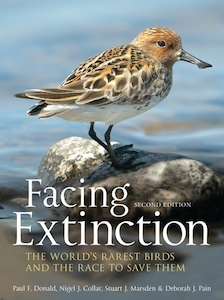It’s widely known among bird watchers as well as general naturalists – both amateur and professional alike – that for as long as humans have been making scientific studies of bird populations, there has been a marked decline in the numbers of many species and an outright disappearance of far more than might be thought ecologically healthy for the planet. However what is not nearly as well known are the circumstances surrounding many of these declines and extinctions. For one thing, contrary to what might commonly be assumed, not all of them are directly the result of human activity, nor are they always irreversible.
As increasing attention has been paid by the popular press to the health of bird populations, the number of books taking up the subject – particularly over the past decade – has not surprisingly also increased. Many of these have included both dire warnings and stirring calls to action, however few have done what has really been needed for a wider public understanding of the subject to be achieved – an honest facing up to the true challenges of bird conservation, both in general as well as in regard to some of the field’s most difficult cases. Which is why Facing Extinction; the World’s Rarest Birds and the Race to Save Them is such a very welcome book indeed.
Written by four of the world’s leading authorities in bird conservation, Dr. Paul F. Donald, Principal Conservation Scientist at the RSPB and Editor-in-Chief of Ibis – the official journal of the British Ornithologists Union; Dr. Nigel J. Collar, Leventis Fellow in Conservation Biology at BirdLife International; Dr. Stuart J. Marsden, Reader in Conservation Ecology at Manchester Metropolitan University and Editor-in-chief of Bird Conservation International, and Dr. Debbie J. Pain is Director of Conservation at the Wildfowl and Wetlands Trust, and was formerly Head of International Research at the RSPB, Facing Extinction presents the reader with both an overview of the nature of species rarity in general as well as detailed, highly readable profiles of twenty rare species of birds.
Making the point quite clearly that not all states of rarity are alike, Donald et al. have clearly chosen their profiled species with great care. By beginning with such divergent cases as the Sociable Lapwing, the Spoon-billed Sandpiper, and the Yellow-crested Cockatoo, a range of different reasons for rarity are clearly explained. Following this, the particular challenges facing island-dependent birds are addressed by focusing on such relevant species as the Stephens Island Wren and the Tristan Albatross.
However it is in the portraits of the measures being taken to preserve rare bird species that most readers will likely find the most reasons for hope. Yet this too is realistically tempered with three bittersweet chapters grouped together under the penultimate section “The Lost and the Found” which brilliantly employs the stories of such species as the Eskimo Curlew and the Gurney’s Pitta to delve into the difficulties of proving a negative – that is, determining when a species truly no longer exists.
Make no mistake, Facing Extinction is a book that addresses some exceptionally difficult-to-face questions regarding bird conservation around the world; however it was written with such care by four of the world’s most noteworthy authorities on the subject that it retains a remarkable level of professional nuance while at the same time being accessible to a wide amateur audience.
 Title: Facing Extinction; the World’s Rarest Birds and the Race to Save Them (2nd edition)
Title: Facing Extinction; the World’s Rarest Birds and the Race to Save Them (2nd edition)
Authors: Paul F. Donald, Nigel J. Collar, Stuart J. Marsden, Debbie J. Pain
Publisher: Bloomsbury
Imprint: Christopher Helm
Format:Paperback
Pages: 320
ISBN: 9781408189665
Published: 19 December 2013
In accordance with Federal Trade Commission 16 CFR Part 255, it is disclosed that the copy of the book read in order to produce this review was provided gratis to the reviewer by the publisher.
This review was originally published in the May / June 2014 issue of Bird Watcher’s Digest.
